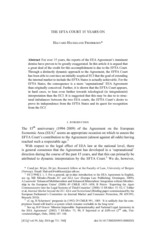| dc.contributor.author | Fredriksen, Halvard Haukeland | eng |
| dc.date.accessioned | 2014-03-24T14:52:20Z | |
| dc.date.available | 2014-03-24T14:52:20Z | |
| dc.date.issued | 2010-07 | eng |
| dc.identifier.issn | 0020-5893 | |
| dc.identifier.uri | https://hdl.handle.net/1956/7885 | |
| dc.description.abstract | For over 15 years, the reports of the EEA Agreement’s imminent demise have proven to be greatly exaggerated. In this article it is argued that a great deal of the credit for this accomplishment is due to the EFTA Court. Through a distinctly dynamic approach to the Agreement, the EFTA Court has been able to convince an initially sceptical ECJ that the goal of extending the internal market to include the EFTA States is actually achievable. For the EFTA States, the consequence is a more ‘supranational’ EEA Agreement than originally conceived. Further, it is shown that the EFTA Court appears, in hard cases, to lean even further towards teleological (ie integrationist) interpretation than the ECJ. It is suggested that this may be due to to structural imbalances between the two EEA courts, the EFTA Court’s desire to prove its independence from the EFTA States and its quest for recognition from the ECJ. | en_US |
| dc.language.iso | eng | eng |
| dc.publisher | Cambridge University Press | eng |
| dc.title | The EFTA Court 15 years on | eng |
| dc.type | Journal article | |
| dc.type | Peer reviewed | |
| dc.description.version | publishedVersion | |
| dc.rights.holder | Copyright 2010 British Institute of International and Comparative Law | |
| dc.identifier.doi | https://doi.org/10.1017/s002058931000028x | |
| dc.identifier.cristin | 340493 | |
| dc.source.journal | International and Comparative Law Quarterly | |
| dc.source.40 | 59 | |
| dc.source.14 | 3 | |
| dc.source.pagenumber | 731-760 | |
